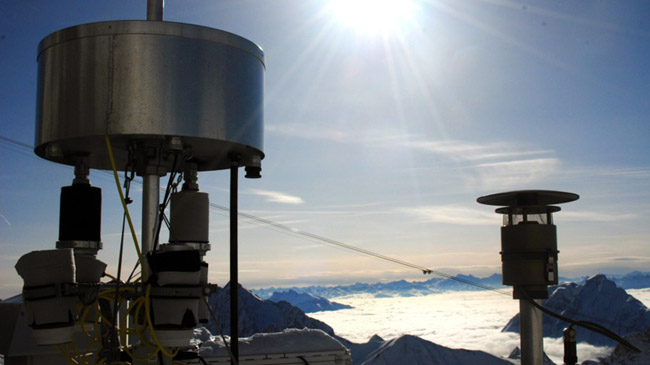 Sampling-Devices for ambient-air and deposition sampling at Mount Zugspitze
Sampling-Devices for ambient-air and deposition sampling at Mount ZugspitzePureAlps was designed to protect the Alps from persistent chemicals which have a potential for accumulation in organisms and which are toxic. Regions with cold climates such as mountain ranges and the poles are especially prone to atmospheric input of such chemicals because of more pronounced condensation at lower temperatures.
Contribution to the regulation of chemicals
In the PureAlps project (2016-2020), pollutant levels in the air (immission) and in precipitation (deposition) were investigated. In addition, the concentrations in the surrounding waters, sediments, soils, and animals were also determined. This made it possible to precisely assess the input and environmental behaviour of environmental chemicals.
The project focused on measuring persistent pollutants such as mercury, brominated flame retardants, and perfluorinated chemicals, which can be detected in trace amounts in many ecosystems. The majority of these pollutants are classified as persistent organic pollutants, or POPs for short. PureAlps investigated the accumulation of these compounds in alpine ecosystems in close cooperation between Bavaria and Austria. The results are available in national and international databases as a basis for the regulation of chemicals or to check whether restriction procedures are effective.
Protecting a Unique Ecosystem
In order to obtain information on the environmental behavior and accumulation of substances in organisms, numerous samples were taken from organisms at different trophic levels. This kind of biota screening makes it possible to identify the pollution situation in the Alps more comprehensively and holistically.
By comparing the atmospherically distributed pollutants with the substances that accumulate in animals, problematic substances can be identified at an early stage and proposed for regulation. By recording trends in pollutant concentrations over time, it is possible to assess whether already regulated and non-regulated substances of concern are becoming an increasing problem.
In many cases, the results of PureAlps monitoring show that regulation at the international level is an effective way of reducing pollution. One example of this is the regulation of endosulfan. The continuation of monitoring and the inclusion of new relevant pollutants are therefore important building blocks for the national and international regulation of chemicals.
 The golden eagle accumulates persistent pollutants which might be a reason for its low reproductivity in the Bavarian Alps.
The golden eagle accumulates persistent pollutants which might be a reason for its low reproductivity in the Bavarian Alps. Monitoring as a Long-Term Task
PureAlps builds on a series of successful predecessor projects. It has been proven that, despite the great distance to various emission sources, more than 100 persistent, bioaccumulative, and toxic compounds, including dioxins, PCBs, OCPs, flame retardants, PFAS, mercury, and pesticides, are transported long distances into the Alps. These include many substances that have not yet been regulated globally.
Although the concentrations in the air are significantly lower than in emission areas, the input of some substances is relatively high due to special climatic and atmospheric processes in the mountains. The underlying effect is known as “cold trapping,” in which substances are preferentially separated from the gas phase in a cold environment. This is clearly shown by the relatively high inputs of dioxins and PCBs compared to their low air concentrations. However, the sometimes high precipitation rates in the Alps also contribute to extensive inputs, as evidenced by the deposition rates for mercury, which are significantly higher in the mountains than in the lowlands.
Influence of regulation, contaminated sites and long-distance transportation
International regulation is having an effect: a large number of regulated substances, particularly from the group of organochlorine pesticides (OCPs), are showing significant decreases as a result of regulation, as are some flame retardants (BDEs). The same applies to the decreasing concentrations of dioxins. For some substances, the decline in concentrations is stagnating due to existing contaminated sites, such as PCBs or OCPs. A distinction must be made between PCBs emitted from diffuse old applications and OCP inputs from incorrect disposal and long-distance transportation.
For the flame retardants, accumulation in living organisms and permanent persistence in the environment was confirmed. The extensive data set shows that the regulations on flame retardants from the group of polybrominated diphenyl ethers (PBDEs) are effective, as the concentrations in the input are lower, but the substances remain permanently in the environment.
The problem of accumulation is shown, among other things, by the fact that although the input is decreasing, the EU environmental quality standards (EQS) for PBDEs in Alpine fish have been exceeded. An additional observation is that regulated flame retardants are being replaced by new substances, which are also classified as problematic due to their persistent, toxic and bioaccumulative properties.
The input of mercury into the Alps from the atmosphere appears to be caused by the global background concentration. Atmospheric processes lead to very high inputs, especially at the edges of the Alps, which are also reflected in pollution of the biosphere. The eggs of great crested grebes in particular showed a very high accumulation of mercury, which can be expected to have toxic effects. For this reason, the Minamata Convention on the global containment of anthropogenic mercury emissions is also highly relevant for the Alpine region.
Comprehensive monitoring necessary for a correct overall picture
Overall, the project shows that comprehensive monitoring is necessary in order to record the overall situation regarding the pollution of Alpine ecosystems with pollutants. The methodologically easier recording in air and deposition makes it possible to recognize new substances of importance, to estimate the input and temporal trends; the determination in living organisms allows conclusions to be drawn about the accumulation and the actual content in the ecosystem.
The levels of persistent organic pollutants in deposition and immission are continuously recorded by the Bavarian Environment Agency (Bayerisches Landesamt für Umwelt, LfU) at the Zugspitze and also made available to the global monitoring program of the Stockholm Convention.
Accumulation in alpine organisms is routinely monitored at certain points in the Berchtesgaden National Park via the Federal Environment Agency's environmental specimen bank. The LfU regularly validates this data through comprehensive studies in alpine organisms (see the projects protectAlps, protectBats, KlimChemAlps).
Contact
If you are interested in the project, please contact:
Bavarian Environment Agency, Evaluation of Substances and Chemicals
- Dr. Korbinian Freier, Tel: +49-(0)-881/93541-1118
Publications
PureAlps - Monitoring Pollutants in the Alps (2020)
The report summarizes the results and findings from PureAlps and its predecessor projects from 2005 to 2019. The focus is on air concentrations and deposition rates of:
- Polychlorinated dibenzodioxins and furans,
- Polychlorinated biphenyls (PCB),
- Polycyclic aromatic hydrocarbons (PAHs),
- Organochlorine pesticides (OCP) and
- Halogenated flame retardants.
The measurements show that chemicals from the group of organochlorine pesticides, in particular, have achieved successes in international chemical regulation, but point to unsolved problems with pollutants such as PCBs. In addition, the measuring stations detect individual novel compounds from the group of flame retardants and organochlorine chemicals, for which international regulation is still pending.
- PureAlps - Monitoring of Persistent Pollutants in the Alps
- Air concentrations and deposition of chlorinated dioxins and furans (PCDD/F) at three high Alpine monitoring stations: Trends and dependence on air masses
- Multivariate statistical air mass classification for the high-alpine observatory at the Zugspitze Mountain, Germany
- Final report (in German)


